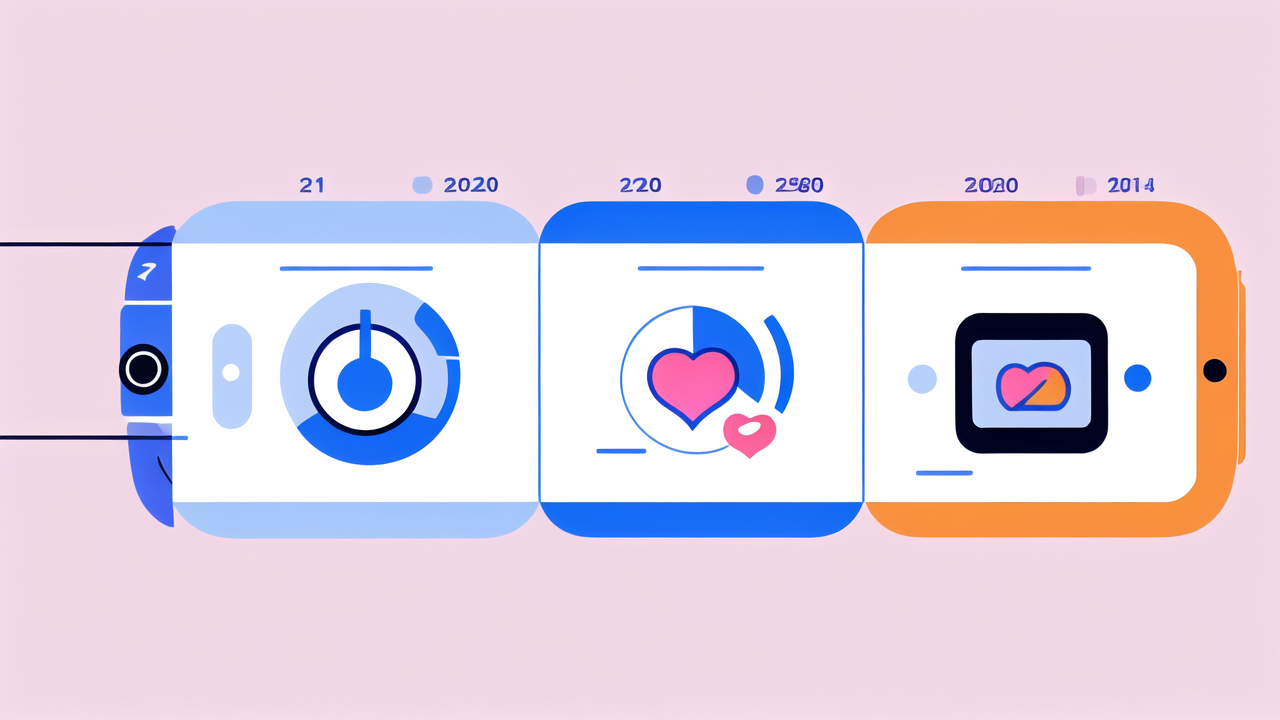The Evolution of Fitness Wearables in the United States
The Origins of Fitness Wearables
Fitness wearables have come a long way since their inception. The journey began in the 1960s with simple pedometers. These devices counted steps and helped people track their daily activity.

In the 1980s, heart rate monitors entered the scene. They allowed athletes to monitor their performance during workouts. The 1990s saw the rise of GPS watches, which were a game-changer for runners and cyclists.
The real boom in fitness wearables started in the early 2000s. Companies like Fitbit and Jawbone launched their first products. These devices combined step counting with sleep tracking and calorie burn estimation.
Key Milestones in Wearable Fitness Technology
Several key milestones have shaped the wearable fitness technology landscape:
- 2006: Nike and Apple collaborate to create Nike+iPod
- 2009: Fitbit releases its first tracker
- 2012: Pebble smartwatch launches on Kickstarter
- 2014: Apple announces the Apple Watch
- 2016: Fitbit introduces sleep stages tracking
- 2018: ECG features become available on smartwatches
- 2020: Wearables start incorporating Covid-19 detection features
Each milestone brought new features and capabilities to fitness wearables. They evolved from simple step counters to sophisticated health monitors.
Current Trends in the U.S. Wearable Fitness Market
The U.S. wearable fitness market is booming. Smart bands and smartwatches dominate the scene. They offer a wide range of features beyond basic fitness tracking.
One major trend is the focus on health monitoring. Devices now track heart rate, blood oxygen levels, and even ECG. Some can detect falls or irregular heart rhythms.
Another trend is the integration with smartphones and apps. This allows for more detailed data analysis and personalized insights. Many devices now offer coaching and workout suggestions.
Customization is also becoming more important. Users want devices that match their style and needs. This has led to a variety of designs and features in the market.
Technological Innovations in Smart Bands
Advanced Sensor and Connectivity Features
Smart bands have come a long way in terms of sensor technology. Modern devices pack an impressive array of sensors into a small package. These include:

- Accelerometers for step counting and motion detection
- Optical heart rate sensors
- GPS for location tracking
- Altimeters for elevation tracking
- Skin temperature sensors
- Blood oxygen sensors
Connectivity has also improved greatly. Most smart bands now use Bluetooth Low Energy for efficient data transfer. Some even offer Wi-Fi or cellular connectivity for standalone use.
NFC technology is becoming more common. It allows for contactless payments and easy pairing with other devices. Some bands also include ANT+ for compatibility with fitness equipment.
Integration of AI and Machine Learning
Artificial Intelligence (AI) and Machine Learning (ML) are revolutionizing smart bands. These technologies help make sense of the vast amount of data collected by sensors.
AI algorithms can detect patterns in your activity and sleep data. They provide personalized insights and recommendations. For example, they might suggest when to exercise or how to improve sleep quality.
ML models can recognize different types of activities automatically. They can tell if you're running, cycling, or swimming without manual input. This improves the accuracy of workout tracking.
Some smart bands use AI to detect potential health issues. They can alert users to irregular heart rhythms or unusually high stress levels. This proactive approach to health monitoring is a game-changer.
Battery Life and Charging Innovations
Battery life has always been a challenge for smart bands. However, recent innovations have led to significant improvements. Many devices now offer battery life of a week or more.
Low-power displays like e-ink and OLED help extend battery life. Efficient processors and better power management also contribute. Some bands use solar charging to supplement battery power.
Charging methods have also improved. Wireless charging is becoming more common. It eliminates the need for cables and makes charging more convenient. Some bands use proprietary chargers for faster charging speeds.
Quick charging technologies allow for rapid top-ups. Many bands can gain several days of use from just a few minutes of charging. This is especially useful for users who forget to charge regularly.
The Impact of Smart Bands on Consumer Health and Wellness
Enhancing Fitness Regimens with Wearable Technology
Smart bands have transformed how people approach fitness. They provide real-time data during workouts, helping users optimize their performance. Features like heart rate monitoring allow for more precise training.

Many smart bands offer guided workouts and training plans. These can be tailored to the user's fitness level and goals. They act as a personal trainer on your wrist, motivating you to stay active.
The ability to track progress over time is a powerful motivator. Users can see improvements in their fitness levels, encouraging them to stick to their routines. Social features allow for friendly competition, adding a fun element to fitness.
Smart bands also help with recovery. They can track sleep quality and suggest optimal rest periods. This holistic approach to fitness helps prevent burnout and injuries.
The Role of Smart Bands in Monitoring Health Metrics
Smart bands have evolved beyond fitness tracking. They now play a crucial role in monitoring overall health. Many devices can track important health metrics continuously.
Heart rate variability (HRV) is one such metric. It can indicate stress levels and overall cardiovascular health. Some bands can detect atrial fibrillation, a serious heart condition.
Sleep tracking has become more sophisticated. Smart bands can now detect different sleep stages and breathing patterns. This data can help users improve their sleep quality and overall health.
Some smart bands can even monitor blood oxygen levels. This feature gained importance during the Covid-19 pandemic. It can help detect respiratory issues early.
Future Outlook: What's Next for Fitness Wearables?
The future of fitness wearables looks promising. We can expect to see even more advanced health monitoring features. Non-invasive blood glucose monitoring is one area of active research.
Wearables may become more integrated with healthcare systems. They could provide valuable data to doctors for better diagnosis and treatment. This could lead to more personalized healthcare.
We might see a shift towards more discreet wearables. "Smart clothing" with embedded sensors could become more common. These could provide even more accurate data without the need for a separate device.
Mental health monitoring is another potential area of growth. Wearables could help detect stress, anxiety, and other mental health issues. They could provide timely interventions and support.
As technology advances, smart bands will likely become even more powerful and versatile. They will continue to play a crucial role in helping people lead healthier, more active lives.




Leave a comment
This site is protected by hCaptcha and the hCaptcha Privacy Policy and Terms of Service apply.